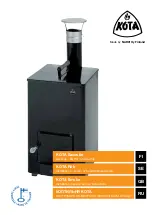
GOLDBERG AND MÄKIVIRTA
OPTIMISED EQUALISATION COMPARISON
AES 116TH CONVENTION, BERLIN, GERMANY, 2004 MAY 8-11
4
indicated on the graphical output (Figure 2). The con-
trol settings and before and after equalisation re-
sponses are shown. The treble tilt, midrange level and
bass tilt controls have been set. The equalisation cor-
rects the low frequency alignment and improves the
linearity across the whole passband.
Figure 3 in Appendix A shows a statistical analysis of
the same loudspeaker presented in graphical form.
The upper three plots were calculated before equalisa-
tion and the lower three plots after equalisation. The
three types of plot display outliers and percentiles in
the magnitude value distribution (box plot), the histo-
gram of values, with a 1 dB resolution, and the fit of
the magnitude values to a normal distribution. These
plots show that the distribution in the magnitude data
has been reduced. This is illustrated by the reduced
range in the box plot and the value histogram and a
steeper curve in the normal probability plot. The fit to
a normal distribution is shown but not discussed fur-
ther. The time taken for the optimisation was 2.43 s.
4.2.2. Graphic Equalisation
Appendix C shows the same case example as above,
but using a graphic equaliser with settings calculated
according the algorithm detailed in Section 3.2. The
settings are shown in Table 2 and plotted in Figure 6.
The effect on the in-situ response can be seen in
Figure 7. Most of the equalisation takes place below
100Hz but some minor adjustment in the in-situ re-
sponse is also made in the midrange to compensate for
resonances due to room modes or constructive inter-
ference due to reflections. An improved linearity
across the whole passband is seen and, in particular,
the low frequency alignment has become better. The
statistical analysis shown in Figure 8 demonstrates
that the magnitude distribution has been reduced. This
is illustrated by the reduced range in the box plot and
the value histogram, and the steeper curve in the nor-
mal probability plot. The time taken for the optimisa-
tion was 29.66 s.
4.2.3. Equalisation Comparison
Comparing the two equalisation techniques, the box
plot, histogram and steeper line in the normal prob-
ability plot all indicate that the distribution of the data
is smaller when graphic equalisation is used. The
room response controls do achieve a good broadband
balance (Figure 2) but the finer detail is not corrected.
In addition to an improved broadband balance,
graphic equalisation is able to correct for local fea-
tures in the response (Figure 7) but only with limited
success. Resonances due to room modes or construc-
tive interference due to reflections in the response
cannot be corrected accurately when the frequencies
do not coincide with the centre frequencies of third-
octave filter bands. A good example of this can be
seen at 600 Hz.
In the room response control equalisation, bass boost
caused by soffit mounting the loudspeaker is corrected
using a single bass tilt filter control set to –8 dB.
Graphic equalisation requires seven filters for this al-
though better low frequency linearity is seen. It is
clear that accurately setting a combination of seven
filters is not a trivial task, especially if time is at a pre-
mium.
The distribution of the room response control equali-
sation’s magnitude response (Figure 3) differs from
the graphic equalisation’s magnitude response (Figure
8). In the latter, there is a skew towards negative val-
ues as only negative gain can be applied to the re-
sponse. In other words, the upward deviations (reso-
nances or constructive interference) are equalised and
the downward deviations (antiresonances or destruc-
tive interference) are not.
The graphic equaliser optimisation took 12.2 times
longer than that for the room response equalisation
optimisation.
5. RESULTS
A total of 67 loudspeakers were measured before and
after equalisation. Of these, 12 were small two-way
systems, 22 were two-way systems, 30 were three-
way systems and three were large systems.
5.1. Room Response Control Equalisation
The detailed results of a statistical analysis for the in-
dividual loudspeakers were discussed in detail in [13].
The subband median levels (Figure 1) illustrate the
broadband frequency balance between the subbands.
Loudspeaker loading from nearby boundaries is re-
flected in the LF subband median level before equali-
sation, especially in the often flush-mounted three-
way and large models. Cancellations from nearby
boundaries are reflected in the low median value of
the LF subband of the small two-way and two-way
systems.
High median levels in the LF subband are reduced af-
ter equalisation, which indicates that equalisation
compensates well for the loudspeaker loading, how-
ever cancellations cannot be equalised. Improvements
in the flatness across subbands of the average subband
median level demonstrates that equalisation can im-
prove the broadband flatness. The largest improve-
ment is seen in the three-way and large systems. The
broadband flatness improvement is mainly the result
of better alignment of the LF subband with the MF
and HF subbands, and a reduction of variation in the





































